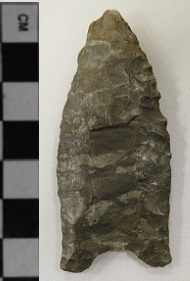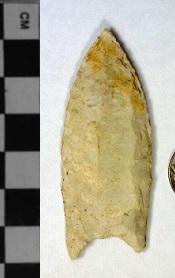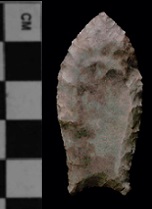Outline is Representative of Size and Shape:
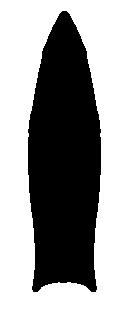
Name Details:
Identified By: William Roosa
Named For: Barnes Creek area in Michigan
Date Identified: 1963
Type Site: Multiple sites in Michigan and into Ontario
Identified By: William Roosa
Named For: Barnes Creek area in Michigan
Date Identified: 1963
Type Site: Multiple sites in Michigan and into Ontario
Point Validity:
Valid type
Roosa was a prominent anthropologist conducting extensive research in Michigan and Ontario while serving as a professor for the Department of Anthropology at the University of Waterloo. He continued on conducting excavations in Texas and the southwestern U.S. This point was named in a professional publication and has many professional references. This is considered a valid type.
Roosa was a prominent anthropologist conducting extensive research in Michigan and Ontario while serving as a professor for the Department of Anthropology at the University of Waterloo. He continued on conducting excavations in Texas and the southwestern U.S. This point was named in a professional publication and has many professional references. This is considered a valid type.
Barnes Auriculate
AKA: Cumberland BarnesCluster: Cumberland Cluster
Description of Physical Characteristics and Flaking Pattern:
This is a medium to large fluted auriculate point. The cross section is flattened where the flute is present and elliptical above the flute. The blade has and outward recurvate shape due to a constrictive waist at the hafting area. Most points have a "fishtail" appearance with the widest portion being just below the midpoint. The blade expands out from the waist forming auricles or ears. The base is concave and may have light grinding along the base and lateral edges. A short flake created by pressure flaking is placed after the flute was created. The face has a long flake(s) or flute(s) that extends from 1/2 to 3/4 of the entire blade face. This point has a well executed parallel to collateral flaking pattern.
Size Measurements:
Length - 35 to 105 mm (mean 61.2 mm), Width - 15 to 25 mm (mean 21.5 mm), Thickness - 3.5 to 8 mm (mean 5.7 mm) Basal Width - 14 to 20 mm (mean 17.4 mm), Basal Concavity - 2 to 6 mm (mean 2.6 mm), Width/Thickness Ratio - 3 to 4.5 / 1
Length - 35 to 105 mm (mean 61.2 mm), Width - 15 to 25 mm (mean 21.5 mm), Thickness - 3.5 to 8 mm (mean 5.7 mm) Basal Width - 14 to 20 mm (mean 17.4 mm), Basal Concavity - 2 to 6 mm (mean 2.6 mm), Width/Thickness Ratio - 3 to 4.5 / 1
Commonly Utilized Material:
Bayport chert, Fossil Hill chert, Collingwood chert, Onondaga chert, Tenmile Creek chert
Bayport chert, Fossil Hill chert, Collingwood chert, Onondaga chert, Tenmile Creek chert
Additional Comments:
This type may be distinguished from the Cumberland type by the "Barnes Finishing" technique commonly seen on the base and the thinner cross section than is commonly seen on the Cumberland type. This type is slightly younger than the Cumberland type. It is thought that the Cumberland type evolved further in the south and migrated into the eastern states. This type evolved from the Cumberland type in the eastern states and migrated into the Great Lakes region and into Canada (W19).
Barnes Finishing Flaking Technique is defined as having a prominent median ridge , longer flutes 1/2 to 3/4 the length of the face. The base is then widened and thinned with a single broad short flake over the primary flute, on both faces. This forms a deeper basal cavity. (Deller and Ellis, 1988).
It has been suggested by Roosa (1963), that this point is diagnostic of the Parkhill Complex in Ontario. This is based on points found at the Parkhill site which were typed as Barnes by Roosa. However, others have suggested that the Parkhill points represent a separate type and not a Barnes point.
This type may be distinguished from the Cumberland type by the "Barnes Finishing" technique commonly seen on the base and the thinner cross section than is commonly seen on the Cumberland type. This type is slightly younger than the Cumberland type. It is thought that the Cumberland type evolved further in the south and migrated into the eastern states. This type evolved from the Cumberland type in the eastern states and migrated into the Great Lakes region and into Canada (W19).
Barnes Finishing Flaking Technique is defined as having a prominent median ridge , longer flutes 1/2 to 3/4 the length of the face. The base is then widened and thinned with a single broad short flake over the primary flute, on both faces. This forms a deeper basal cavity. (Deller and Ellis, 1988).
It has been suggested by Roosa (1963), that this point is diagnostic of the Parkhill Complex in Ontario. This is based on points found at the Parkhill site which were typed as Barnes by Roosa. However, others have suggested that the Parkhill points represent a separate type and not a Barnes point.
Distribution: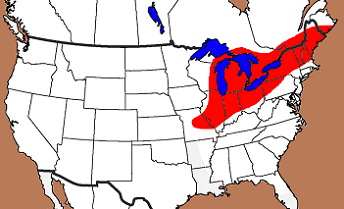

Distribution Comments:
This point is primarily found in the Susquehanna and Hudson River Valley's and into the Great Lakes Region. Distribution extend to southeastern Ontario and southern Quebec. This point is found into the Ohio River Valley with decreased frequency. This point has (Cumberland / Barnes) been reported into Ontario (49 examples), Quebec (3 examples), Nova Scotia (144), and Maine (6 examples) by the 2010 PIBDA. However, these points rarely reported in these areas and this overlaps with the similar Debert point. These points may represent variations of the Debert point.
This point is primarily found in the Susquehanna and Hudson River Valley's and into the Great Lakes Region. Distribution extend to southeastern Ontario and southern Quebec. This point is found into the Ohio River Valley with decreased frequency. This point has (Cumberland / Barnes) been reported into Ontario (49 examples), Quebec (3 examples), Nova Scotia (144), and Maine (6 examples) by the 2010 PIBDA. However, these points rarely reported in these areas and this overlaps with the similar Debert point. These points may represent variations of the Debert point.
Age / Periods:
Date: 11,000 - 9,000 B.P.
Cultural Period: Late Paleo
Glacial Period: Late Pleistocene to
Early Holocene
Culture: Parkhill Complex
Date: 11,000 - 9,000 B.P.
Cultural Period: Late Paleo
Glacial Period: Late Pleistocene to
Early Holocene
Culture: Parkhill Complex
Age Details:
At the Dutchess Quarry Cave in Orange County, New York this type was radiocarbon dated at 12,530 +/- 370 B.P.
At the Dutchess Quarry Cave in Orange County, New York this type was radiocarbon dated at 12,530 +/- 370 B.P.
Other points in this cluster / Related / Associated Points:


